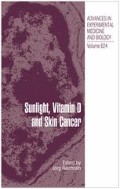Abstract
To get an optimal vitamin D supplement from the sun at a minimal risk of getting cutaneous malignant melanoma (CMM), the best time of sun exposure is noon. Thus, common health recommendations given by authorities in many countries, that sun exposure should be avoided for three to five hours around noon and postponed to the afternoon, may be wrong and may even promote CMM. The reasons for this are (1) The action spectrum for CMM is likely to be centered at longer wavelengths (UVA, ultraviolet A, 320–400 nm) than that of vitamin D generation (UVB, ultraviolet B, 280–320 nm). (2) Scattering of solar radiation on clear days is caused by small scattering elements, Rayleigh dominated and increases with decreasing wavelengths. A larger fraction of UVA than of UVB comes directly and unscattered from the sun. (3) The human body can be more realistically represented by a vertical cylinder than by a horizontal, planar surface, as done in almost all calculations in the literature. With the cylinder model, high UVA fluence rates last about twice as long after noon as high UVB fluence rates do.
In view of this, short, nonerythemogenic exposures around noon should be recommended rather than longer nonerythemogenic exposures in the afternoon. This would give a maximal yield of vitamin D at a minimal CMM risk.
Access this chapter
Tax calculation will be finalised at checkout
Purchases are for personal use only
References
Setlow RB, Grist E, Thompson K et al. Wavelengths effective in induction of malignant melanoma. Proc Natl Acad Sci USA 1993; 90:6666–6670.
Diffey BL, Healy E, Thody AJ et al. Melanin, melanocytes and melanoma. Lancet 1995; 346:1713.
Moan J, Dahlback A, Setlow RB. Epidemiological support for an hypothesis for melanoma induction indicating a role for UVA radiation. Photochem Photobiol 1999; 70:243–247.
Hocker T, Tsao H. Ultraviolet radiation and melanoma: a systematic review and analysis of reported sequence variants. Hum Mutat 2007; 28:578–588.
Wood SR, Berwick M, Ley RD et al. UV causation of melanoma in Xiphophorus is dominated by melanin photosensitized oxidant production. Proc Natl Acad Sci USA 2006; 103:4111–4115.
Galkin ON, Terenetskaya IP. ‘Vitamin D’ biodosimeter: basic characteristics and potential applications. J Photochem Photobiol B 1999; 53:12–19.
MacLaughlin JA, Anderson RR, Holick MF. Spectral character of sunlight modulates photosynthesis of previtamin D3 and its photoisomers in human skin. Science 1982; 216:1001–1003.
Author information
Authors and Affiliations
Editor information
Editors and Affiliations
Rights and permissions
Copyright information
© 2008 Landes Bioscience and Springer Science+Business Media
About this chapter
Cite this chapter
Moan, J., Dahlback, A., Porojnicu, A.C. (2008). At What Time Should One Go Out in the Sun?. In: Reichrath, J. (eds) Sunlight, Vitamin D and Skin Cancer. Advances in Experimental Medicine and Biology, vol 624. Springer, New York, NY. https://doi.org/10.1007/978-0-387-77574-6_7
Download citation
DOI: https://doi.org/10.1007/978-0-387-77574-6_7
Publisher Name: Springer, New York, NY
Print ISBN: 978-0-387-77573-9
Online ISBN: 978-0-387-77574-6
eBook Packages: Biomedical and Life SciencesBiomedical and Life Sciences (R0)

